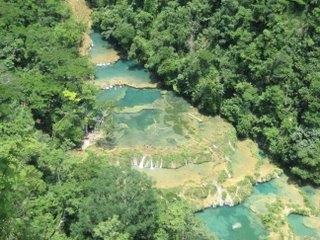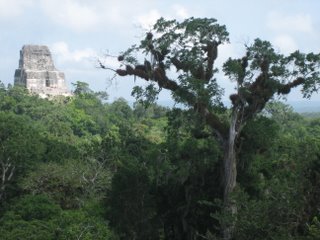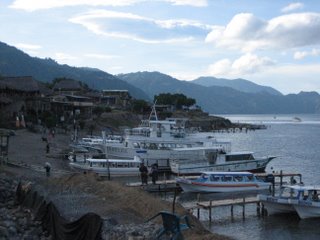Hello
I came across these 2 videos of Gardening by Join Robert Norris, Associate Professor and Associate Botanist at UC Davis. They're each an hour long but definitely worth seeing. Is a class presentation so it can get a bit dull, but the material is excellent and his comments are thoughtful and funny.
Here is the first part:
and the second part:
Enjoy
Monday, September 25, 2006
Vegetables Gardening Videos
Sunday, September 24, 2006
School Gardens as a Tool Against Food Insecurity

Hello All, I know it's been a while since my last post, but I've been very occupied gathering material to what is going to be a busy blog for the coming weeks.
School Gardens: I arrive to Nicaragua about a month ago. I've been working (or rather volunteering) on the Special Programs on Food Security, task force set up by the Food and Agriculture Organization of the United Nations. As an Agricultural Economist, I have the task of evaluating, from an economical point of view, the viability of school gardens when it comes to reduce food insecurity. As mentioned earlier, I have been busy visiting schools mainly in the north of the country (Somoto, Jinotega, Esteli, Madriz). Initially, I though of doing a Cost-Benefit Analysis, but the project is quite diverse and most of the benefits are in form of intangibles e.g. education, better nutrition, etc. So allow me to discuss the rationale behind the school gardens and why is it can be difficult to analyze them.
In Nicaragua about 30% of the population, especially in the rural areas, is considered food insecure. This means that they cannot produce or acquire enough food for an adequate diet. Since the repercussions of undernutrition are enormous especially in children, one must think of an immediate solution that puts food in the people's tables. Therefore, school gardens should serve as providers of nutritional food that kids can eat in their school lunch or take with them to their homes. And some school gardens are doing just that.
However, most schools don't have the experience, resources, and/or technical assistance to maintain a garden that will produce an output significant in the kids’ diet. When this is the case, we justify the gardens as methodical tools that make the learning process easier. Proponents and literature argue that gardens can be use in the teaching of math, biology, other sciences, and even language using the concept of "learning by Doing". The rational behind this is that practice will guarantee that the kids will learn the material better and easier. If this is the case, then he will be more prepared to face a situation of food insecurity. He/she for instance can get a job easier, can help their parents in their business, can even set up a garden in his house or in other words can get food easier. Sounds very good but is that really the case? How can we know? And more important is it the best choice given our limited resources?
These are some of the questions I have to struggle with for the next three months. To me is very easy to conclude that a school garden is an effective tool against food insecurity when this garden is producing lots food that is being used in the school kitchen, the kids’ homes, or even process and sold. If this is the case, is simply a matter of comparing the US$250 that cost to set up and maintain a garden for a year with the benefits: lots of food probably worth more than the garden cost, not to mention improved nutrition, education, social skills etc.
But when the gardens do not produce a significant amount of food, then is hard to see whether or not school gardens are a good tool against undernutrition. Here is the case when the intangibles must be quantified and numbers must be given to kids doing gardening. It is hard as an economist realizing that such a wonderful experience as gardening may not the best thing to do given the difficult challenges they’re facing.
I’ll keep you posted as I come up with answers to these questions. As always check the pictures at www.flickr.com/photos/rafamerchan
Best,
Labels:
Nicaragua,
School Gardens
Thursday, September 07, 2006
Top Three Sites in Guatemala
 Hello All,
Hello All,Sorry it's been so long to write a post, but I've been very busy with my new job: I'm working with FAO on Special Programs in Food Security. My assigment is to analize the economics of School Gardens. These are being introduced as tools to combat food insecurity. Stay tunned, in the meantime check my three favorite places in Guatemala.
TOP 1 River Semuc Champey
(Picture on top)
This beautifull river is located in the Mountains of Alta Verapaz, about a hour from Coban. The river goes down on a cave while the lime-formed pools are filled with springs from the mountain. There are tours you can take from Coban.

TOP 2 Tikal
The most amazing of all the Mayan sites according to many, Tikal is an exellent place to expirience the beautifull pre-columbus building of the Mayas and a lush, rich in wildlife rain forest. In the picture to the left you can see the Ceiva tree, sacred to the Mayan, and one of the many temples of the city.

TOP 3 Lake Atitlan
And my last pic, Lake Atitlan is a unique lake surounded by two volcanos and mountains tops and rich in Mayan culture that you can find the the many towns that inhabit the lakes edges. Panajachel, the largest town, is very crowded filled with tourist and craft sellers. Take a bout to one of the smaller towns for some tranquility.
Labels:
Trip Pics
Subscribe to:
Posts (Atom)
